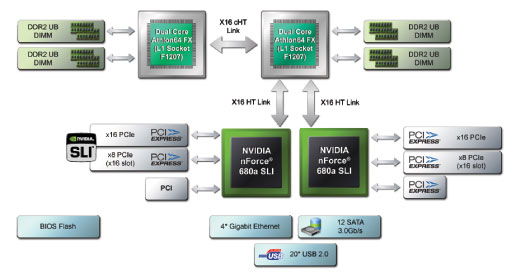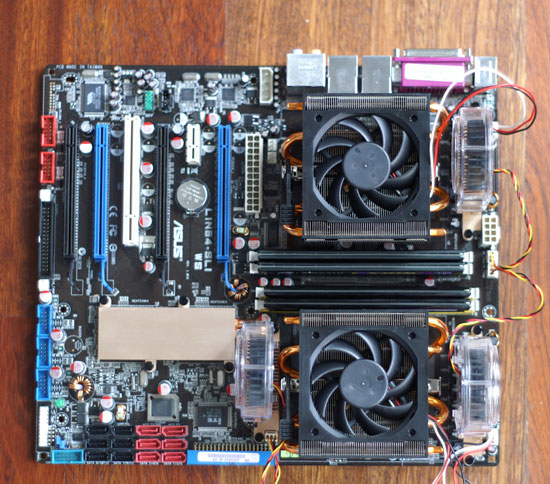AMD's Quad FX: Technically Quad Core
by Anand Lal Shimpi on November 30, 2006 1:16 PM EST- Posted in
- CPUs
The Platform
With the recent ATI acquisition under its belt, AMD has started down the path of becoming a platform company. As such it's almost fitting that the most interesting part of today's story isn't the CPUs, but rather the chipset and motherboard that complete Quad FX.
When AMD first talked about Quad FX as 4x4, everyone assumed that we would be looking at a pair of Socket-AM2 CPUs on a desktop motherboard. However as we got closer to launch it quickly became evident that Quad FX would be using Opteron's new Socket-1207 instead. The reason for using Socket-1207 instead of AM2 is simple; in a single socket AM2 system you only need a single Hyper Transport link between the CPU and the chipset, which is provided for in AM2 CPUs. However, with two sockets you need a minimum of two links, one connecting the two sockets and one for the chipset. It's the number of HT links required that forced the 1207-pin socket upon Quad FX. We will get to how this impacts your upgrade path and CPU costs later, but for now just know that Quad FX only works with 1207-pin Athlon 64 FX CPUs (Opterons are prevented from working in the BIOS).
Despite the ATI acquisition, the only Quad FX chipset available at launch is from NVIDIA. Dubbed the nForce 680a, NVIDIA once again gives us a reason to respect its platform group. Although singular in name, the nForce 680a is composed of two 680a SLI chips, each with a x16 and x8 PCIe slot. One of the two chips has an additional 8 PCIe lanes bringing the total up to 56 lanes, more than any other NVIDIA chipset, including the recently released 680i.

The madness doesn't end with the sheer number of PCIe lanes; the 680a also supports a total of four GigE ports, twelve SATA ports and twenty USB 2.0 ports. All of the usual nForce features are present on the 680a, including SLI support, RAID and NVIDIA's networking (FirstPacket and Teaming support). The chipset is a pure beast and we were eager to see an implementation of all of the PCIe, GigE, SATA and USB ports that the 680a supports on the first Quad FX motherboards; unfortunately we were met with disappointment.

AMD's Quad FX platform is launching with a single motherboard partner, ASUS, and a single Quad FX motherboard: the L1N64-SLI WS. The ASUS board features four physical x16 slots (two x16 and two x8), a single x1 PCIe slot and one regular PCI slot.

You also get all twelve SATA ports, but there's only support for ten USB ports and two GigE ports. Obviously the number of people that will complain about not having all twenty USB ports and four GigE ports are limited, but with AMD expecting the L1N64-SLI WS to retail for around $370, we wanted all of the bells and whistles.

We asked AMD when we could expect other Quad FX motherboard designs but at this point it looks like the ASUS solution is it. AMD is working with more motherboard partners but there's no indication if or when additional Quad FX designs will surface.

AMD is guaranteeing a bit of an upgrade path to early adopters of Quad FX by promising that these motherboards will work with AMD's native quad-core CPUs when they are available next year, meaning you'll get support for eight cores in the same platform in less than a year.










88 Comments
View All Comments
peternelson - Thursday, November 30, 2006 - link
I image www.Scan.co.uk in the UK will stock both boards and cpus at realistic street pricing.
And I am seriously thinking of getting one, to put lots of PCIe cards into, and for use WITH A NUMA AWARE OPERATING SYSTEM.
Who knows, Asus may even release a bios upgrade for it!
And also note that there is a similar Asus "Deluxe" board not just the WS workstation variant, so may be a little cheaper.
My other options are a dual socket Opteron board (with expensive memory) or a Core2Quad, using Nvidia 680i chipset which gives less I/O capacity.
Anonymous Freak - Friday, December 1, 2006 - link
Or, you could go for a dual socket Xeon system. It would cost near the same, and you'd have the option of two quad-core processors RIGHT NOW. (Rather than late next year.)Of course, then you run into more expensive (and more power-hungry) memory. But if you are actually looking at such a system, a Xeon might be a better fit.
mino - Friday, December 1, 2006 - link
The problem IS the memory and I/O, these are the strenghts of this solution.Prices of cheap 4C WS solutions:
HIGHEST PERFORMANCE 4C: -> systems have comparable performance (Vista/XPx64 in account)
-------------------------------------------------
***Quad FX:
1pc FX-74 $1000
1pc MB $350
4pcs 1G RAM $400
1pc Fortron PSU $100
0pcs 8-port SATA controller $0
----------------
Total: $1750
***Core 2 Quad:
1pc QX6700 $1000
1pc MB $250
4pcs 1G RAM $400
1pc Fortron PSU $60
1pc 8-port SATA controller $150
---------------
Total: $1860
BEST VALUE 4C: -> systems have comparable performance[except QX6700] (Vista/XPx64 in account)
-------------------------------------------------
***Quad FX:
1pc FX-70 $600
1pc MB $350
4pcs 1G RAM $400
1pc Fortron PSU $100
0pcs 8-port SATA controller $0
----------------
Total: $1350
***Core 2 Quad:
1pc QX6700 $1000
1pc MB $250
4pcs 1G RAM $400
1pc Fortron PSU $60
1pc 8-port SATA controller $150
---------------
Total: $1860
***Opteron 2000:
2pcs 2216 $1200
1pc MB $400
4pcs 1G RAM $600
1pc Fortron PSU $100
1pc 8-port SATA controller $150
---------------
Total: $2450
***Xeon 5100:
2pcs 5150 $1200
1pc MB $400
4pcs 1G RAM $700
1pc Fortron PSU $100
1pc 8-port SATA controller $150
---------------
Total: $2550
IDEAL WS/PC Solution: (best value proposition, upgrade possible when necessary)
----------------------------------------------
1/2pcs FX-70 $300
1pc MB $350
2pcs 1G RAM $200
1pc Fortron PSU $60
0pcs 8-port SATA controller $0
---------------
Total: $910
The funny thing beeing, the biggest value of QuadFX is in the exceptional motherboard. Except those those 10 not routed USB ports, that board is a dream come true.
And yes, those 12 SATA3G ports would be a blessing for my storage needs...
peternelson - Friday, December 1, 2006 - link
Nice costings, I'm thinking the same here.
That board has lots of I/O bandwidth.
Since the Gbit ether ports support teaming (2 muxed together), I would have thought it worthwhile for Asus to implement all four rather than two.
Four used separately would make nice routing between lans, and four used as two teamed pairs would give > 1Gbps performance in and out eg as a firewall, or as a server with redundant connection, or to talk to NAS boxes etc. Two extra nets wouldn't push the power consumption up by much.
Hopefully Asus (or other) will produce a rev2 board with the extra ethernets.
Lonyo - Thursday, November 30, 2006 - link
There's support for 14 USB ports AFAIK, 4 on the back, and 5 headers on the mobo, which makes 14 I think, which still isn't 20, but it's more than enough, and it's more than 10 :P
mino - Friday, December 1, 2006 - link
No, those 2 headers are for IEEE1394...SLIM - Thursday, November 30, 2006 - link
Is this just a prelim review only talking about the processors and the real review is still to come? I mean the only reason for this platform to exist is the 4 GPUs not the cpus. Let's see 4 8800gtx's with the FX74s playing at insane resolutions in games that intel simply can't fathom due to the lack of support for 4 gpus (at least as far as I know of).The 4 gpus are the point of this platform, not power consumption, not 3dsmax... GAMES WITH 4 GPUS! I don't mean to be too abrupt, but the boards got 4 graphics slots for a reason.
Spoelie - Friday, December 1, 2006 - link
A single 8800gtx is already being bottlenecked by a core 2, let alone them in SLI.Quad SLI will not have any performance advantage over SLI, as the processing power to feed them is just not there.
PrinceGaz - Thursday, November 30, 2006 - link
I dread to think what the power consumption of a system with the FX-74s and four 8800GTX cards would be. It would probably be close to 1KW, possibly even around 1100W or so. That would be insane!JarredWalton - Thursday, November 30, 2006 - link
Given that this "4x4" initiative is apparently going to use NVIDIA graphics cards, and NVIDIA makes both AMD and Intel chipsets, if they decide to do anything with quad G80 chips you can pretty much guarantee that it will be for both platforms. Thus, 4x4 is really 2x2 right now, whereas the 775 platform is 1x4 and Xeon is 2x4. In the future, AMD will have 2x4, and perhaps all the platforms will support some silly quad GPU configuration.Basically, quad SLI was all about the pissing contest. "Oh yeah, well I have for GPUs and you only have two!" Then there was the completely bogus marketing material that they sent out with quad SLI talking about how great the extra GPUs would be for accelerating physics calculations. I suppose it's possible that in the future such applications will become useful, but almost a year after the initial talk of NVIDIA physics acceleration and we have yet to see any actual demonstration of this capability. Anyway, this Quad FX is just the same thing as Quad SLI: potentially good marketing, but lackluster final performance and terrible heat and power requirements.